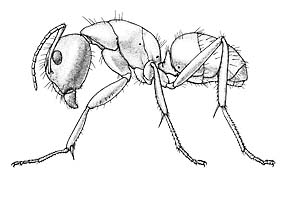|
Lastly, the order Hymenoptera is a large order containing individuals such as ants, bees, wasps, and a group of plant feeders commonly called sawflies. We write "sawflies" as one word to indicate that they are not true flies. We write the common name of "true flies" as two words such as black fly, horse fly, or deer fly to indicate that they are members of the order Diptera. Sawfly larvae are plant feeders on the foliage of conifers or deciduous plant material. Some are even known to bore into plant tissue.
Worldwide there are 108,000 different species. In North America north of Mexico there are 17,200 different species in the order Hymenoptera. Members of this order have holometabolous or complete metamorphosis. They have two pairs of wings. Mouthparts of adults in this order are described as being chewing or chewing-lapping.
One of the distinctive features of members of this order is that their membranous wings have few veins. Additionally, the base of the abdomen is often constricted. You can see these characteristics in the two illustrations associated with this order of insects.
As a side note, landscape managers are often asked questions by folks playing a round of golf or looking at something they may have collected at their own homes. These clients often ask, "Is this a winged ant or is this a termite?"
Examine the two illustrations provided. You can first note with a winged termite that the antennae are straight; whereas, if you look at a winged ant, the antennae are described as being elbowed.
Additionally, when you look at the wing veins in a winged ant, there are very few veins apparent when compared to the presence of many veins in the wings of an eastern subterranean termite.
Another characteristic to look for when identifying a winged ant is that you can see three distinct body regions. The head, thorax, and abdomen are apparent on the ant. When you look at the illustration of the winged termite, you can see the head, but the juncture of the thorax and the abdomena isn't as easily seen.
I hope you'll find the characteristics listed above useful to you when answering this common question posed to golf course superintendents and turfgrass or landscape managers.
|

Ant
Order: Hymenoptera
Family: Formicidae
|

